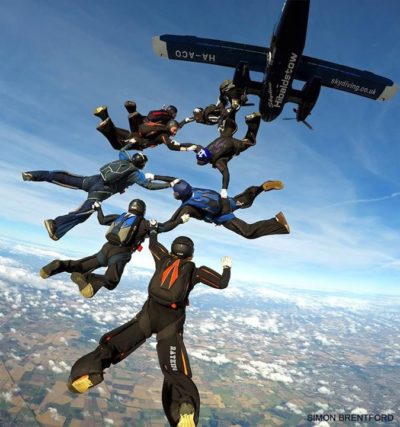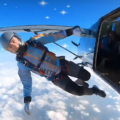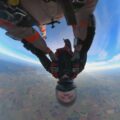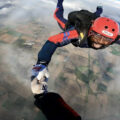- Swallow Group Dropzones:
- Skydive Hibaldstow
- Skydive Spain
- Skydive Algarve
Unusual Questions: Part 1
Tuesday, May 19, 2020
Welcome to the first a new series titled Unusual Questions. The idea comes from a series of questions posed on our Skydive Hibaldstow Experienced Jumpers group to get some answers our talented community of jumpers who’ve always wondered what would happen in a variety of situations. It’s often when you feel silly for asking something which to others might be obvious, but to you isn’t, that we want to give you the answers! Originally, we had planned to do around 3 or 4 questions per blog piece, but the first one answered by Sian Stokes really was a big subject in its own right, so we’ve dedicated the whole article to her!
I keep going low on smallish bigways (around the 6 to 12-way size), any tips?
Answered by Sian Stokes, a well-known bigway load organiser and member of team NFTO
There are a few points to consider with this question:
- Firstly, When do you usually go low?
- Is it on approach or during skydive?
- If on approach do you go low and continue to lose altitude or just go passed the formation and stay a metre or so below?
If the first, this would suggest it is a fall rate issue so using the right tools to make sure you are in the same fall rate range as the rest of the group and also selecting the correct exit and slot position to make it more comfortable. If the latter this would suggest your approach is too fast and you’re stopping too late. To fix this issue stop a little earlier on your approach to bleed off excess speed and use a stadium approach to fly to your slot. Every metre out you should have roughly half a metre height.
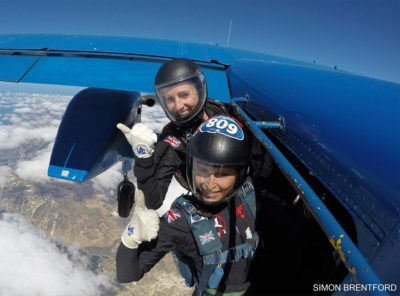 If you tend to go low during the skydive it maybe fall rate, caused by you being out of range or the formation slowing down as people are picking up grips. It is important for the base to maintain a decent fall rate throughout and this is matched by everyone as they arrive. If you are in the base make sure you have the correct tools to allow this (it might mean wearing weight when you don’t always). This is to allow you to stay comfortable even if there is lift created when people pick your grips up. If on the outside, expect it to feel slower as you approach, set up in a stadium approach and continue to reference through centre of formation as this will help you preempt any changes in fall rate.
If you tend to go low during the skydive it maybe fall rate, caused by you being out of range or the formation slowing down as people are picking up grips. It is important for the base to maintain a decent fall rate throughout and this is matched by everyone as they arrive. If you are in the base make sure you have the correct tools to allow this (it might mean wearing weight when you don’t always). This is to allow you to stay comfortable even if there is lift created when people pick your grips up. If on the outside, expect it to feel slower as you approach, set up in a stadium approach and continue to reference through centre of formation as this will help you preempt any changes in fall rate.
Make sure you come to a full stop before picking up your grips. Regardless of your slot it is important to Fly your slot, the work isn’t over when you arrive and pick up your grips! Put yourself in your comfort zone Exit position, put yourself in an exit slot you feel confident flying, that may be floating or early diver (it’s a personal preference, there is no ‘easy slot’) If you have confidence from the moment you exit the aircraft, this will put you in a better mental state from the start. From setting up in the door, to exit, to approach you should identify where the base is and where it will be when you arrive.
Always expect the unexpected, if you or someone else has an unstable exit then your pictures and approach will be different, so have your eyes wide open! Make sure your arrival is something you are proud to be shown on the bar tape! It’s always better to take a fraction longer to stop and take your grip rather than approaching and funnelling the whole formation.
Other notes to consider to use the right tools:
- Weight belts
- Baggy/tight jumpsuit – different materials can help with fall rate, for example, poly-cotton is slower than nylon.
- T-shirt/jumper on top to give drag – remember if you are adding any tools such as a t-shirt you need to make sure it cannot lift and cover your handles! Get an instructor to check it out if any doubt.
- Webbed gloves, not as common nowadays but still a good tool to help approach, but won’t help when in your slot and you have picked up your grips.
- Booties, they give more power and lift.
The better your body position and more relaxed you are, the easier it is! You should be in the middle of your range so you can always go faster or slower when needed. Be in the right mental state! Half of the difficulty with skydiving is the mental game. Positive thinking and using the time in the plane to visualise the whole skydive is the best tool you have. Spend the time on the ground to see the right pictures to avoid distraction in the air, such as who is in the base, where your slot is, where your approach is.
If you have all of this information, then you can concentrate more so on flying your slot, any small fall rate fixes you may need throughout and then of course the fun and safety of tracking away and canopy flight! Be a lucky skydiver, see more, have fun. You will soon be able to fly any slot on a 6-12 way, this is no different to the slots on a 200 way!
Pic credits: James Stevenson and Simon Brentford
We are so social...
Follow Us!
Stay connected with us! Sign up to receive news and valuable promotions from Skydive Hibaldstow! We won’t spam you (we promise).
Copyright © 2024, Skydive Hibaldstow, All Rights Reserved.
DropZone Web Design & Marketing by Beyond Marketing, LLC
